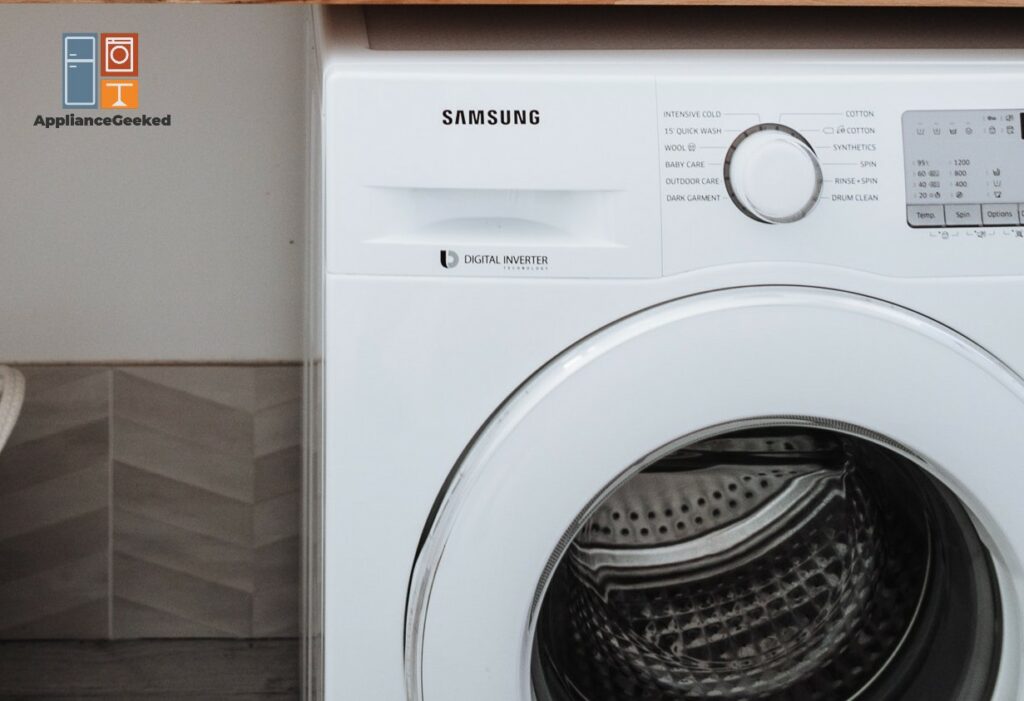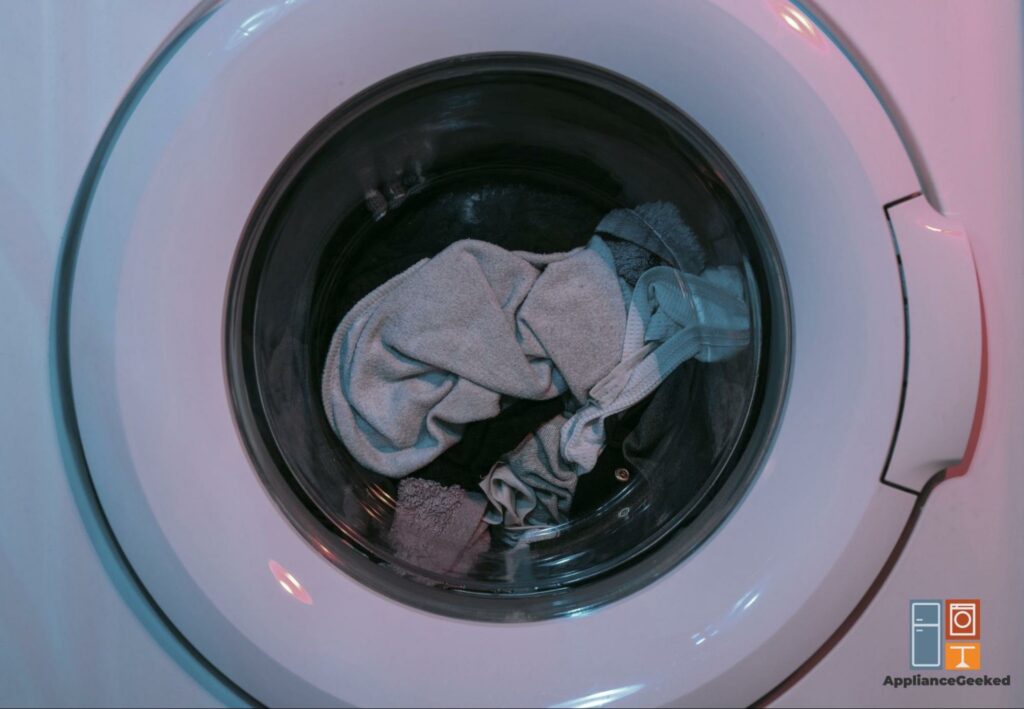
Just like a bad hair day, a 4E washer error code is quite common, and it happens at the worst possible moments.
On the bright side, there is no need to go out and buy a new washing machine. All of the fixes for the 4E error are simple to do and don’t require special tools or technical know-how.
Here, we provide step-by-step instructions to help you resolve the 4E error and get your Samsung washer back in working condition.
What does a Samsung Washer 4E code mean?
A 4E error code means that your Samsung washer isn’t receiving enough water to fill the drum and run a cycle. Kinked or blocked water supply hoses are the most common culprits.
Other Samsung washers may display a 4E error when the detergent drawer is clogged. A good clean should clear the error.
Since error codes vary across different Samsung washer models, the 4E error may appear as 4C or NF “No Fill”(Samsung washer NF code) on some units.
Until the problem is resolved, the washer can’t fill up with enough water to run a cycle. Thus, you’ll have to troubleshoot it to get back to your laundry.
How to Resolve a 4E Error Code on a Samsung Washing Machine
To fix a 4E error code on a Samsung washer, check if the unit is connected properly to a water supply and make sure the taps are fully open.
Remove blockages in the hoses and mesh filters to improve the flow of water into your washer. Straighten out any kinks and bent areas in the hoses as well.
Below, we will walk you through all the steps to resolve the 4E error code on your Samsung washer. Just follow our instructions so you can carefully and confidently perform the appropriate solutions yourself.
| Causes | Fixes |
| Closed or Disconnected Water Supply | • Unplug the washer, and turn off the water supply. • Connect the hot and cold water lines to their respective taps. • Tighten the fittings by hand. Then, use a wrench to secure the fittings but refrain from fastening them too tight. • Pull both of the hoses down to secure them. • Place the unconnected ends of the hoses inside a bucket. Turn on the taps for 10 to 15 seconds to remove dirt from the hoses. • Then, close the taps. • Connect the water supply hoses to the intake connections on the washer. • Install the fittings by hand and use a wrench to secure them. Make sure not to overtighten the fittings. • Plug in the washer, and turn on the taps. Check if the error is resolved. |
| Kinked or Blocked Water Supply Hose | • Unplug the washer, and turn off the water supply. • Rotate the hot and cold inlet hoses counterclockwise to disconnect them. • Hold the loose ends of the hoses over a bucket. Then, briefly open the taps to check the flow of water from both hoses. • Inspect the hoses for kinks and bent areas if water doesn’t flow out of them. Straighten them out if you find any. • Check clogs in the hoses as well, and remove any visible obstructions. • Reconnect both hoses and make sure the connections are watertight. • Plug in the washer and turn on the tap. Then, test if it fills with water. |
| Clogged Mesh Filters | • Unplug the washer, and turn off the water supply. • Rotate the water inlet hose counterclockwise to remove it. • Use pliers to pull out the mesh filter. Clean the filter with a cotton swab, or soak it in water until it’s clean. • Let the filter dry before inserting it back into place. • Reconnect the hose. Make sure that the connection is watertight. • Plug in the washer, and turn on the tap. Check if it fills with water. |
| Uncleaned Detergent Drawer | • Open the detergent drawer. • Push the release lever on the softener compartment and pull out the drawer at the same time. • Remove the softener compartment and liquid detergent guide from the drawer. • Clean the detergent drawer using an old toothbrush. Then, rinse it under running water. • Use a soft cloth or an old toothbrush brush to clean the detergent drawer recess. • Wipe the detergent drawer, softener compartment, and liquid detergent drawer until they are fully dry. • Push the softener compartment and liquid detergent guide into the drawer to reinstall them. • Align the drawer with the rails and gently push it back in. Make sure the drawer opening is fully dry before you reinstall the drawer. |
Closed or Disconnected Water Supply
A 4E error code doesn’t always mean that there is something wrong with your washer. It also appears when the water supply hoses aren’t connected properly or when you forget to turn on the taps.
It might sound silly, but it does happen—even to the best of us!
On the bright side, you have nothing to worry about or troubleshoot. Just inspect the hot and cold water supply lines and connect them properly to the washer and the taps.
Then, make sure the taps are fully open.
Solution: To install the water supply hoses on a Samsung washer, follow these steps:
- Step 1: Unplug the washer, and turn off the water supply.
- Step 2: Connect the hot and cold water lines to their respective taps.
- Step 3: Tighten the fittings by hand. Then, use a wrench to secure the fittings but refrain from fastening them too tight.
- Step 4: Pull both of the hoses down to secure them.
- Step 5: Get a bucket and place the unconnected ends of the hoses inside.
- Step 6: Turn on the taps for 10 to 15 seconds to remove dirt and grime trapped inside the hoses. Then, close the taps.
- Step 7: Connect the water supply hoses to the intake connections on the washer.
- Step 8: Install the fittings by hand and use a wrench to secure them. Make sure not to overtighten the fittings.
- Step 9: Plug in the washer, and turn on the taps.
- Step 10: Check if the error is resolved.
| Tips: • The ends of the hot and cold water lines that connect to the washer must have rubber gaskets to prevent leaks. • Never use tape or sealant on the faucets or water supply hoses to prevent damage to the fittings. • Connect the water supply hoses to their appropriate intake connections. Interchanging the lines can lead to an NF or NO Fill error (nF, NF2, or nF2). |
Kinked or Blocked Water Supply Hose
If your washer is slow to fill up with water, it’s most likely a water supply issue. It could be caused by either low water pressure or low flow rate.
Your water pressure should be around 0.5 bar to 8 bar. If the water supply hose is kinked, pinched, or blocked, the flow will be restricted, preventing your washer from filling up.
Solution: To fix kinked or blocked water supply hoses, follow these steps:
- Step 1: Unplug the washer, and turn off the water supply.
- Step 2: Rotate the hot and cold inlet hoses counterclockwise and pull them out.
- Step 3: Place the loose ends of the hoses into a bucket.
- Step 4: Briefly open the water supply taps to check the flow of water from both hoses.
- Step 5: Inspect the hoses for kinks and bent areas if water doesn’t flow out of them. Straighten them out if you find any.
- Step 6: Open the taps again for 10 to 15 seconds to remove any foreign substances that may have clogged the hoses.
- Step 7: Reconnect both hoses and make sure the connections are watertight.
- Step 8: Plug in the washer and turn on the water supply.
- Step 9: Check if the error code is resolved.
Clogged Mesh Filters
Another common cause of a 4E error code on a Samsung washer is a clogged mesh filter. Each supply line has its own filter that traps dirt and debris from the water, preventing them from entering the drum during wash cycles.
If you don’t clean them regularly, the filters can get clogged and obstruct the flow of water. It will trigger a 4E error code once the appliance detects that no water is flowing into the drum from the supply hoses.
As a result, your washer can’t operate efficiently and clean your clothes properly. It can also increase energy expenses in your household.
Solution: To clean a water hose mesh filter, follow these steps:
- Step 1: Unplug the washer, and turn off the water supply.
- Step 2: Rotate the inlet hose counterclockwise and pull it out. Cover the hose with a cloth to absorb any accidental spills when you disconnect it.
- Step 3: Pull out the mesh filter by hand. Use pliers if it is stuck.
- Step 4: Use a cotton swab to clean the filter, or soak it in water until it’s clean.
- Step 5: Let the filter fully dry before reinstalling it.
- Step 6: Insert the filter back into place using pliers.
- Step 7: Reconnect the hose and make sure the connection is watertight.
- Step 8: Repeat the same steps to clean the second mesh filter.
- Step 9: Confirm that the connections are tight.
- Step 10: Plug in the washer and turn on the tap. Then, test if it fills with water.
Uncleaned Detergent Drawer
Depending on your Samsung washer model, a 4E or 4C error code may appear when the detergent drawer is clogged.
Bleach, detergent, and softener residue can accumulate in the drawer, which can cause sewage smells and leakages. It can even affect the cleaning performance of your washing machine.
Instead of having clean laundry, you’ll see chalky bits of residue all over your clothes and inside the drum. If left uncleaned, mold can grow in the crevices of the drawer, stain your clothes during wash cycles, and make them smell musty.
Solution: To clean the detergent drawer on a Samsung washer, follow these steps:
- Step 1: Open the detergent drawer.
- Step 2: Push the release lever on the softener compartment and pull out the drawer at the same time.
- Step 3: Remove the softener compartment and liquid detergent guide from the drawer.
- Step 4: Use an old toothbrush to scrub the detergent residue. Then, rinse the drawer under running water.
- Step 5: Use a soft cloth or an old toothbrush brush to clean the detergent drawer recess.
- Step 6: Wipe the detergent drawer, softener compartment, and liquid detergent drawer until they are fully dry.
- Step 7: Reinstall the softener compartment and liquid detergent guide into the drawer.
- Step 8: Align the drawer with the rails and gently push it back in. Make sure the drawer opening is fully dry before you reinstall the drawer.
Preventative Measures and Maintenance Tips
The best way to prevent error codes is by cleaning your Samsung washing machine regularly. It can reduce breakdowns and costly repairs.
Here are a few tips that can help you prevent the occurrence of error codes on your Samsung washer.
Clean your washer regularly.
If your unit has a Self-Clean function, we recommend running a cycle every month or two depending on your usage. Or, you can run a cycle as soon as the Self-Clean indicator light starts blinking.
The Self-Clean reminder may appear after 40 washes on a Samsung front-load model. On top-load units, it may appear after 20 washes.
You won’t need to use bleach if you’re using the Self-Clean cycle for routine maintenance. However, if it’s to get rid of mold or mildew smells, you can add bleach to the cycle.
Since not all Samsung washers have a Self-Clean function, you can manually clean your washer every month. Run a hot cycle to remove mold, bacteria, and residue build-up inside the drum.
Although vinegar and baking soda are inexpensive and effective cleaning ingredients, you should refrain from using them on your washer. Samsung advises against the use of these natural ingredients as they may damage the internal components of your unit.
Practice good laundry habits.
Practicing good laundry habits can help you keep the washer in tip-top shape. For instance, weighing your laundry and using the right amount of detergent for its load can help you avoid a range of issues, including water leaks and unpleasant smells.
Like many others, we used to think that more suds will make your clothes cleaner. However, too much detergent actually reduces the cleaning performance of your washer, making your laundry feel sticky and slimy after a wash.
Excess detergent can pool inside the detergent drawer and clog it up. For some Samsung washers, this will trigger a 4E error code, which you can resolve by clearing the gunk off the drawer.
Install your washer properly.
After routine cleaning and maintenance, make sure that you reinstall all of your Samsung washer’s components properly. Always inspect the hoses for kinks and straighten them out to prevent water supply issues.
Inspect the hoses and filters for signs of damage as well. If you find any, get a replacement part for your specific model before the faulty component causes further damage to your washing machine.
Although it is possible to perform the replacement yourself, you can opt to request service if you aren’t confident. Just be prepared to spend at least a few hundred dollars for the fix, as well as the replacement part.
Frequently Asked Questions
If your washer displays a 4E code when the drum is full, it might be caused by a control board glitch. Like most error codes caused by a glitch, it isn’t triggered by a problem in the washer and should clear after you reset the appliance.
Just unplug the washer or turn it off at the circuit breaker. Keep it disconnected from its power source for 1-5 minutes to clear the electrical charge.
Then, plug it back in and turn it on. After power cycling the washer, the 4E code on the display should disappear.
A Samsung washer 4E error code is easy to troubleshoot and rarely requires professional services. In most cases, a deep clean can resolve the error and get your washer to start filling with water again.
Whether you’re dealing with a clog in the water supply hose, mesh filter, or detergent drawer, you can remove any obstruction with deep cleaning. It should only take a few minutes of your time.
If the 4E error code persists after you clean the water supply hoses, mesh filters, and detergent drawer, we recommend calling a professional who can inspect your Samsung washer and diagnose the problem.
They can also perform the necessary repairs to resolve the error.
There have been no recalls of Samsung washers due to the 4E error code.
Although it is a common issue, it is simple to fix and even easier to prevent. With proper cleaning and maintenance, you can avoid the 4E error code from recurring.



